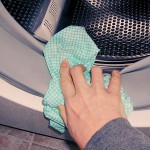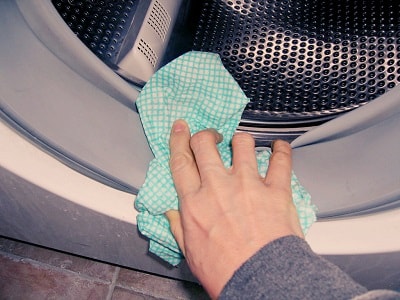 In this article we will tell you how to clean the drum of a washing machine from dirt and scale. During the operation of the washing machine, over time, dirt and lime deposits accumulate in it, which lead to the formation of mold and unpleasant odors. A thick layer of limescale can lead to overloading and seizure of the motor and failure of the heater. Therefore, you should periodically clean the drum of the machine from dirt and deposits inside, as well as clean the drain filter and cuffs. You can do it yourself without spending money on calling the wizard or delivering the unit to the service center.
In this article we will tell you how to clean the drum of a washing machine from dirt and scale. During the operation of the washing machine, over time, dirt and lime deposits accumulate in it, which lead to the formation of mold and unpleasant odors. A thick layer of limescale can lead to overloading and seizure of the motor and failure of the heater. Therefore, you should periodically clean the drum of the machine from dirt and deposits inside, as well as clean the drain filter and cuffs. You can do it yourself without spending money on calling the wizard or delivering the unit to the service center.
Before you clean the drum of your washing machine yourself, it is helpful to carefully read the instruction manual for periodic maintenance procedures.
To clean the washing machine drum yourself, you need to know the following things:
- Why does dirt and scale build up in the machine?
- How and how to clean the drum?
- What else needs to be cleaned in a typewriter to prevent failures?
How lime and mineral deposits form in the machine
Dirt, sand, and foreign objects get into the machine's tank together with the washing and tap water. Scale and mineral deposits are formed as a result of the use and heating of hard water with a high content of salts and metals. Scale is harmful because, accumulating in a thick layer, it disturbs the balance of the drum mechanism and can lead to its jamming, and deposited on the heating element, it reduces its effectiveness and leads to burnout of the heating element or fuse.
To soften water and fight scale, manufacturers recommend using special products, for exampleCalgon for washing machine, but they should not be abused, as they contain chemical additives that shorten the life of the rubber seals and the coating of the machine parts. It is much safer to use special cleaning filters installed at the water inlet of the plumbing system.
To reduce the ingress of dirt, sand and foreign matter into the tank, the following preventive measures should be taken:
- pre-clean all pockets and lapels of linen from foreign objects, pieces of dried dirt, sand, lint, debris, etc.;
- shake out the dust from the laundry before placing it in the drum;
- wash the laundry by placing it in a fine cloth bag.
![]() See also - How to properly clean your washing machine at home
See also - How to properly clean your washing machine at home
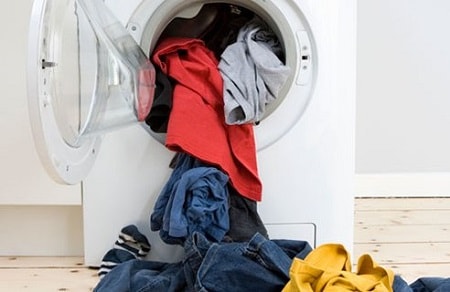
How to clean the drum of a washing machine
The drum can be cleaned manually or automatically using one of the machine's washing modes. To do this, you need to use various chemicals. These can be both expensive special cleaning products and ordinary, familiar to everyone, improvised substances that are often used in the kitchen. Commonly used folk cleaning products include:
- vinegar essence;
- baking soda;
- whitening solution "Whiteness";
- lemon acid.
- special cleaning agents
Vinegar essence
Vinegar essence diluted with water in a ratio of 1: 3. The main advantages of the vinegar solution include:
- high efficiency of action, cleans the drum, tank and ten;
- does not require much human effort;
- cheap and affordable stuff.
The disadvantage of vinegar is the shortening of the service life of rubber parts in contact with it and the long retention of odor inside the washer after cleaning.
Baking soda
The inner walls of the drum can be peel with baking soda from oil and dirt, without mechanical action, the soda solution will not remove scale on the heater and the surface of the tank. In order to clean the drum of an automatic machine, you need about 150g. soda. The advantages of soda include:
- the harmlessness of the substance for the washing machine;
- availability and low cost;
- lack of smell and environmental safety.
The disadvantage of using baking soda is the need to manually wipe off the dirt from the parts, as well as the provision of time for effective dissolution of deposits in the alkaline solution.
White
Chlorine bleaches of the "Whiteness" type, which have a high chemical activity of their constituent components, are distinguished by their good efficiency in removing dirt and scale. To completely clean the walls of the drum, 250 g is enough. Whiteness. The advantages and disadvantages of whiteness are the same as those of vinegar, so it is not recommended to use it often for cleaning the machine. You can use the product once a year. In addition, chlorine bleach fumes are harmful to human health.
Lemon acid
Citric acid has gained the greatest popularity as a cleaning agent for the washing machine. Dirt, mold, greasy deposits, scale, both from the drum and from the surface of the heating element and tank, can clean with citric acid solution... To clean the drum surface, 200g is enough. powder. Unlike vinegar concentrate and bleach, citric acid is harmless to rubber seals and metal surfaces of assemblies and parts, so it can be used more often, given that this powder is much cheaper than its competitors in terms of price. Only a very thick layer of salt deposits may not be able to cope with citric acid.
Special cleaning agents
According to consumer ratings and reviews, the best cleaning detergent for washing machines considered to be Frisch Activ liquid of German production. This is absolutely safe for the unit, but a very active tool that can be used at least weekly. It effectively and quickly removes scale and greasy dirt from all parts of the machine with which it interacts. In addition, it has a pleasant odor that has a deodorant effect. Despite the high cost of liquid, one 250ml bottle. up to 10 cleaning procedures can be performed.
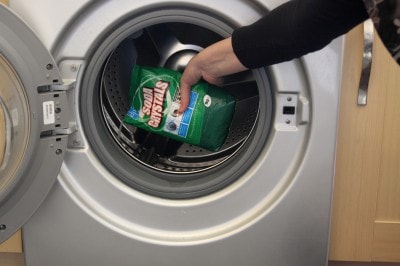
Detailed instructions for cleaning the drum
The efficiency, safety and quality of cleaning the washing machine depends on the correct dosage and correct use of the above products.
Cleaning with vinegar essence
Vinegar, citric acid or whiteness diluted with water is poured into the tank, then set one of the washing programs for 60 minutes or more without intermediate draining of water, set the washing temperature to at least 60C and start the machine. After the end of the washing program and the water has been drained, rinse twice in order to completely remove the remaining solution from the tank. Timely execution of such a procedure will give an excellent result: dirt and deposits from the drum surface will completely come off.
We clean with baking soda
To manually clean the walls of the drum with baking soda, follow these steps:
- wipe the walls of the drum with a wrung out damp cloth so that they are slightly moistened;
- pour the powder onto a rag and wipe the inner drum surface with it until dirty deposits and scale begin to dissolve;
- take a break for half an hour so that the soda eats away the stuck sediments and greasy spots;
- continue work on cleaning the drum walls until the deposits are completely eliminated;
- at the end of work, turn on the machine in rinsing mode and rinse the drum.
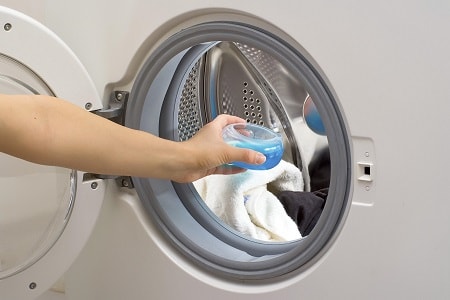
Cleaning method with special means Frisch Activ
To clean the machine, the special tool Frisch Activ, you must do the following:
- pour one half of the measuring cap of the liquid into the receiving pocket of the machine (dish for washing powder);
- pour the other half of the cap with liquid directly into the tank through the hatch opening;
- start a washing mode with a high temperature of 70-90C without draining the water;
- after the end of the program, pause for half an hour, allow the old scale to soften in an active aqueous solution;
- then run the machine in rinsing mode and drain the water.
Modern advanced washing machines are equipped with a special drum cleaning program, which automatically cleans it from mold and grease. For descaling, use this mode with the Frisch Activ cleaning agent.
What else needs to be cleaned in the washing machine?
A visual inspection of the drum walls can be carried out through the opening of the hatch. Their condition is used to judge the degree of contamination of other internal parts that are invisible from the outside. If limescale or dirt on the drum is clearly visible, it is safe to say that there are significantly more of them on the tank and ten. The following elements of the washing machine are subject to mandatory regular cleaning from fat, dirt and salt deposits:
- water drainage path with a drain filter;
- loading door cuff;
- tank from the inside;
- heating heaters;
- drum pulley.
Also, according to the instructions, every time at the end of the wash it is necessary to clean the drain filter, drain hose and cuff. This is due to the fact that almost every wash leaves behind various solid debris in the tub: loose fittings, fibers, threads, hair, pieces of cloth or paper, which can get stuck in the filter, preventing the dirty water from draining.
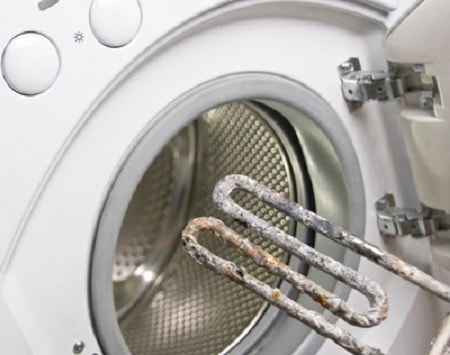
The folds of the cuff often collect dirt and fine sand, which, when wet, is an excellent breeding ground for mold and other bacteria. Therefore, in order not to need replacing the cuff on the washing machine, at the end of the wash, be sure to wipe dry all folds of the cuff. The formed mold can be cleaned with whiteness, vinegar or copper sulfate diluted with water, thoroughly wiping the infected area with a cloth soaked in this solution.
In advanced cases, when deposits have accumulated over the years, and they cannot be removed using the above methods, it is necessary to disassemble the washing machine and clean all the specified parts manually by mechanical means using professional cleaning agents. However, it should be remembered that only a trained master can properly disassemble the washing machine. It is better for an inexperienced owner not to try to do this, since the drum unit of a washing machine - an automatic machine is a precisely balanced mechanism, a violation of which can cause it to break down in the future.
Thus, to ensure reliable operation of the washing machine and a long service life, to obtain a high quality wash with a pleasant smell of linen, it is imperative to periodically clean the drum, at least once a year, or even more often, depending on the intensity of use of the machine. Now you know how to clean the drum of a washing machine from dirt and you can achieve a brilliant result both literally and figuratively.
See also:

